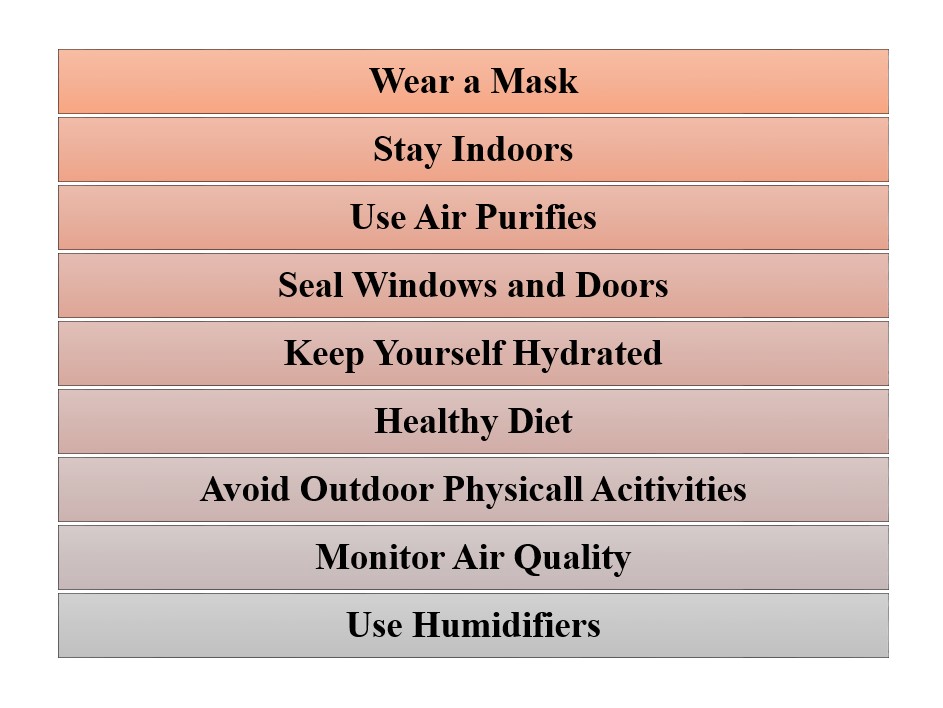Smog is a major environmental challenge and become a critical issue in Punjab during the winter months.
This issue rise from the buildup of harmful pollutants such as particulate matter (PM2.5, PM10), nitrogen oxides(NOx), sulfur dioxide(SO2), and volatile organic compounds.
These pollutants react with sunlight to form a thick, harmful haze.
However, smog impacts health and the environment badly such as respiratory issues, reduced visibility, and damage to the ecosystem.
So, with this rising issue, the Punjab government has taken anti-smog initiatives and advised some preventive measures to control this issue.
Here, we discuss some measures to combat air pollution.
What is Smog
The mixture of fog and smoke is called smog. It is formed with the release of nitrogen compounds, hydrocarbons and other waste chemicals in the form of coal mixed with air and sunlight.
What is the Cause of Smog in Punjab?
The most populous cities of Punjab such as Lahore, Faisalabad, and Gujranwala are facing the worsening issue of smog. However, this issue returns every winter with a greater intensity.
Major contributing factors are immense traffic pollution, crop burning, and industrialization. These have led to major health issues including lungs, eyes, skin and heart problems.
Although the government has taken some measures to mitigate these dangerous effects of smog but they have proven to be of little significance.
So, some important efforts are still needed as well as public cooperation will play a crucial role in controlling this issue.
Why is Punjab’s air quality so bad?
The quality of air in Punjab is poor due to emissions from cooking and heating fires, crop fires mixing with urban pollution from industry, windblown dust as well as a range of other sources.
The Government of Punjab has taken some helpful steps to counter the toxic effects of this air pollution. Public transport projects such as Metro bus, Orange line train, and Speedo bus have been launched in an effort to reduce traffic pollution.
Moreover, reforestation is also a top priority in the current government’s anti-smog campaign.
So, crop burning has also been banned and heavy fines have been imposed on the offenders.
Top 6 Anti-Smog Measures
The main cause of smog is the mixing of air with pollutants and exhaust gases resulting from human activities.
Here are some measures to implement which prevent extreme smog and its impacts.
Use Hybrid or Electric Vehicles
Vehicle emission is one of the main causes of smog. Vehicles release pollutants such as nitrogen oxide and particulate matter.
However, using electric cars eliminate these emissions which ultimately reduce the smog.
To take this initiative Government should provide incentives like subsidies, tax breaks, and urge citizens to switch to a cleaner environment.
Moreover, the adoption of electric vehicles improves the air quality which minimizes the health-related issues.
Senior Punjab Minister Mariam Aurangzeb said” an e-mass transport system has been introduced with 30 e-buses and e-bikes set to operate in Lahore soon.
Furthermore, the government is also banned smoke-emitting vehicles, including government-owned ones, from entering Lahore.
Industrial Emission Control
Industrial emission includes the formation of smoke from factories, refineries, and power plants.
The government takes the initiative to combat this issue by introducing advanced technologies for filtration.
By implementing this innovative technology, industries reduce the release of harmful gases such as sulfur dioxide and volatile organic compounds.
Furthermore, promotes cleaner energy sources such as solar, natural gas, and wind which reduce the dependence on smog-producing fossil fuels. This is the most focused anti-smog measure.
Improve Public Transportation System
Encourage citizens to use public cars instead of private cars which reduces the number of vehicles on the road, thereby lowering emissions.
Invest in affordable public transport options such as trains, buses, and subways. This minimizes the number of private vehicles on the road.
Moreover, the development of bicycle lanes also contributes to reducing vehicle emissions.
Planting More Tree
Trees and plants are act as natural air filters which absorbs carbon dioxide and other harmful pollutants while releasing oxygen.
However, invest in green urban planning strategies like plant more tree along streets, create more parks, and make green roofs which helps to reduce smog.
Furthermore, implement large-scale afforestation projects, especially in and around industrial zones as well as highways.
This will help to reduce the concentration of airborne pollutants.
So, green spaces not only improve air quality but also improve the overall condition of urban living.
Implement a Smog Alert System
A Smog alert system is the best anti-smog measure that can help cities to respond quickly when pollution level rise.
These systems develop in a way that you can get real-time information on air quality.
However, authorities take temporary measures to control pollution during high smog days.
The EPA officials said the industrial city had been selected for launching the initiative under the guidance of Punjab Senior Minister Marriyum Aurangzaib and EPA Director General Dr Imran.
They said that an EPA inspection team equipped with advanced drones had been deployed to monitor air pollution.
Reduce the Use of Fossil Fuels
Buy renewable energy to reduce the use of fossil fuels. Renewable energy sources are:
- Solar
- Wind
- Hydropower
These sources are long-term anti-smog measures.
Moreover, fossil fuel burning is a significant contributor to smog creation.
However, to improve the quality of air, reduce the dependence on coal, gas, and oil for power generation.
The government should take the initiative to adopt clean energy by offering subsidies, investing in renewable energy infrastructure, and set carbon reduction targets.
Generating electricity from clean sources promotes energy efficiency in offices, homes, and factories.
As well as it can reduce overall emissions.
How Smog Affects Your Health
Smog is a common type of air pollution. Pakistan has been dealing with this climate issue for a number of years.
As a result, many people have an issue of illness and health issues.
Moreover, air pollution was designated a “Human Carcinogen” by the WHO (World Health Organization).
WHO reported a 6.5 million death rate worldwide due to air pollution and smog.
Smog can lead to respiratory problems, cardiovascular illness, and Cancer.
According to the study, people are more likely to breathe in harmful airborne substances when the air quality index declines.
However, smog irritates our airways when it is inhaled and it raises the risk of lung and heart problems.
It also causes the disease of burning eyes, throat, coughing, and wheezing.
Here are some anti-smog measures you can take to prevent yourself during times of high pollution:
Conclusion
Smog is a major issue in Punjab and Pakistan is considered as the world’s ranked country which is more polluted.
However, anti-smog measures are essential for individual health.
So, by implementing the above measures, we can mitigate the health risks associated with smog and create a cleaner environment.




